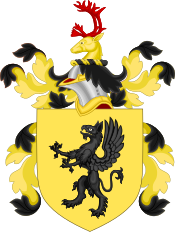Miles Morgan
John grew disgusted with the bigotry, superstition, and the persecutions (including the witch trials) then taking place in New England and moved to Virginia.
Miles joined the company of Sir William Pynchon in the colonization of western Massachusetts and was one of the founders of the city of Springfield, originally named Agawam after the Indian tribes that lived in the area.
She accepted and in 1642, accompanied by an Indian guide, a pack horse, and two companions, Miles set out for Beverly, where the couple were married.
During the fighting that swept the colony during King Philip's War in 1675 the Indians attacked Springfield, nearly destroying the town.
An Indian servant who worked for Morgan managed to escape and alerted the Massachusetts Bay troops under the command of Major Samuel Appleton, who broke through to Springfield and drove off the attackers.
("...up in ye gallery, to give a check to disorders in youth and young men in tyme of God's worship").
[1] On 5 October 1675,[2] Springfield was attacked by the native inhabitants, and Morgan's blockhouse became a fortress of the place, and, after the burning of the settlement, held out until messengers had been despatched to Hadley.
Captain Samuel Appleton, with a force of men (the standing army of the Massachusetts Bay Colony), marched to Springfield and raised the siege.
A bronze statue of Captain Miles Morgan in Court Square in Springfield shows him in huntsman's dress and cocked hat, with a rifle over his shoulder.

